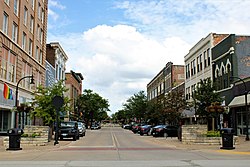
Orangeville is a village in Stephenson County, Illinois, United States. The town's sign lists the population at 800 as of January 2021. The population in 2020 was 738. The population according to the 2010 census was 793, up from 751 in 2000. Using the 2020 population of 738 Orangeville is the 741st largest city in Illinois and the 11,650th largest city in the United States. Orangeville is currently declining at a rate of -0.94% annually and its population has decreased by -6.94% since the 2010 census. The area's earliest white settlers arrived in the year 1833, and the village was platted in 1851 by John Bower, who is considered the village founder. In 1867 Orangeville was incorporated as a village. The town's central business district contains several 19th century commercial buildings, many of which were built during the railroad boom of 1888–1914. By the time the Great Depression was ongoing, business in Orangeville had started to decline, with the last bank closing in 1932. In 1956 another bank started operating in the village and is still in town today. Some recent infrastructure jumps have restored some of the village's old decor.

Rockford is a city in Winnebago County, Illinois, United States. Located in the far northern part of the state on the banks of the Rock River, Rockford is the county seat of Winnebago County. The largest city in Illinois outside of the Chicago metropolitan area, Rockford is the fifth-largest city in the state and the 171st most populous in the United States. In the 2020 census, Rockford had a population of 148,655 anchoring the Greater Rockford Metropolitan Area with a population of 348,360.

The Sycamore Historic District is a meandering area encompassing 99 acres (400,000 m2) of the land in and around the downtown of the DeKalb County, Illinois county seat, Sycamore. The area includes historic buildings and a number of historical and Victorian homes. Some significant structures are among those located within the Historic District including the DeKalb County Courthouse and the Sycamore Public Library. The district has been listed on the National Register of Historic Places since May 2, 1978.
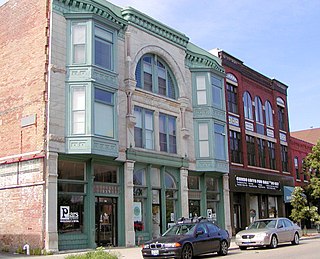
The Bloomington Central Business District is a historic district in downtown Bloomington, Illinois. The district includes roughly twelve square blocks of the city and encompasses 140 buildings, 118 of which are contributing buildings to the district's historic character. The 1901 McLean County Courthouse, the center of government of McLean County, is the focal point of the district. The other buildings in the district were built between 1842 and 1942 and are primarily commercial. The Miller-Davis Law Buildings, two of the oldest buildings in the district, were built in 1843 and represent the early period of Bloomington's development. Bloomington's commercial core grew rapidly during the 1850s and 1860s after two railroads opened in the city; while the 1854 Gridley Bank is the only surviving pre-1857 building from this period, several more remain from the later part of the boom. The city continued to grow, and its business district continued to expand, from 1860 until 1900; however, a fire destroyed much of its downtown in 1900. Several buildings in the district date from the rebuilding period of the early 1900s.

The United States Courthouse, also known as the Federal Building, is a historic building located in Davenport, Iowa, United States. It has historically housed a post office, courthouse, and other offices of the United States government. The building now serves only as a federal courthouse, housing operations of the eastern division of the United States District Court for the Southern District of Iowa. In 2018, the operations of the Rock Island division of the United States District Court for the Central District of Illinois were also moved there.

Davenport Bank and Trust Company were for much of the 20th century the leading bank of the Quad Cities metropolitan area and the surrounding region of eastern Iowa and western Illinois. It was at one time Iowa's largest commercial bank, and the headquarters building has dominated the city's skyline since it was constructed in 1927 at the corner of Third and Main Streets in downtown Davenport, Iowa. It was acquired by Norwest Bank of Minneapolis in 1993 and now operates as part of Wells Fargo following a 1998 merger of the two financial institutions. The historic building was listed on the National Register of Historic Places in 1983 under the name of its predecessor financial institution American Commercial and Savings Bank. In 2016 the National Register approved a boundary increase with the Davenport Bank and Trust name. It was included as a contributing property in the Davenport Downtown Commercial Historic District in 2020. It remains the tallest building in the Quad Cities, and is today known as Davenport Bank Apartments as it has been redeveloped into a mixed-use facility housing commercial, office, and residential space.

The Davenport Hotel is a historic building located in downtown Davenport, Iowa, United States. It was individually listed on the National Register of Historic Places in 1983. In 2020 it was included as a contributing property in the Davenport Downtown Commercial Historic District. It is currently an apartment building called The Davenport. A rear portion of the building collapsed in 2023 putting the building's future in doubt.

The Scott County Jail is the main detention facility for Scott County, Iowa, United States. Inmates are housed for no more than one year, by Iowa law. It is located in the county seat, Davenport, and is part of same facility as the Scott County Courthouse.

The Burtis–Kimball House Hotel and the Burtis Opera House were located in downtown Davenport, Iowa, United States. The hotel was listed on the National Register of Historic Places in 1979. It has since been torn down and it was delisted from the National Register in 2008. The theatre building has been significantly altered since a fire in the 1920s. Both, however, remain important to the history of the city of Davenport.

Fort Armstrong Hotel is a historic building located in downtown Rock Island, Illinois, United States. It was individually listed on the National Register of Historic Places in 1984. In 2020 it was included as a contributing property in the Downtown Rock Island Historic District. The hotel was named for Fort Armstrong, a fortification that sat in the middle of the Mississippi River near the present location of the Rock Island Arsenal. The building now serves as an apartment building.

The Moline Downtown Commercial Historic District is a nationally recognized historic district located in Moline, Illinois, United States. Centered on 5th Avenue, it is roughly bounded by 12th Street to 18th Street, 4th Avenue to 7th Avenue. The distinct covers 33-acre (0.13 km2) and includes 114 buildings. One hundred of the buildings contribute to the significance of the district because they retain their historic and architectural integrity and reflect the character of the historic downtown.

Peoples National Bank Building–Fries Building are two historic buildings located in downtown Rock Island, Illinois, United States. They were listed together on the National Register of Historic Places in 1999. They were included as contributing properties in the Downtown Rock Island Historic District in 2020.The buildings were built separately, but have subsequently been connected on the first three floors.
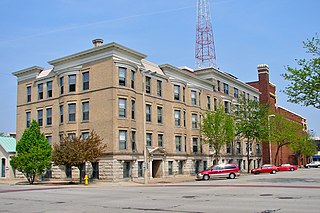
The Sala Apartment Building is a historic building located in Rock Island, Illinois, United States. It was individually listed on the National Register of Historic Places in 2003. In 2020 it was included as a contributing property in the Downtown Rock Island Historic District.

Edward Hammatt was an architect in the United States. He designed several notable buildings that are listed on the National Register of Historic Places.

The Portsmouth Downtown Historic District encompasses the historic urban core of Portsmouth, New Hampshire. With a history dating to the 17th century, Portsmouth was New Hampshire's principal seaport and the center of its economy for many decades, and the architecture of its urban center is reflective of nearly four centuries of history. The district is roughly L-shaped, radiating from the downtown Market Square area to South Street in the south and Madison and Columbia streets in the west, with more than 1,200 historically significant buildings. It was listed on the National Register of Historic Places in 2017. The district includes 35 previous listings on the National Register, and five National Historic Landmarks.

The LaSalle Downtown Commercial District is a national historic district in downtown LaSalle, Illinois. The district encompasses 93 contributing buildings which historically formed the commercial and governmental center of LaSalle. Development in downtown LaSalle began with the completion of the Illinois and Michigan Canal in 1837 and the construction of railroads through the city in the 1850s; it continued through the mid-twentieth century. The district's commercial buildings represent many architectural styles, with popular styles of the late nineteenth century such as Italianate, Queen Anne, and Romanesque Revival being the most common. Significant government buildings include the LaSalle City Building and two post office buildings.

The Davenport Downtown Commercial Historic District is a nationally recognized historic district located in the central business district of Davenport, Iowa, United States. It was listed on the National Register of Historic Places in 2020. At the time of its nomination it consisted of 43 resources, which included 33 contributing buildings, one contributing structure, and nine non-contributing buildings. In addition, the district also contains 33 buildings that are individually listed on the National Register. This historic district is bordered by four other districts: the Crescent Warehouse Historic District and the Davenport Motor Row and Industrial Historic District on the east, the Hamburg Historic District to the northwest, and the West Third Street Historic District on the west.
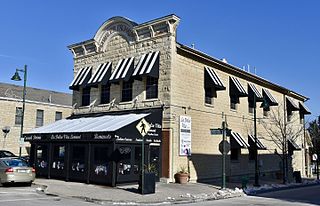
The Lemont Downtown Historic District is a commercial historic district encompassing 14 city blocks in downtown Lemont, Illinois. The district has served as the village's downtown since the 1850s, when the newly opened Illinois & Michigan Canal and subsequent limestone quarrying in the area sparked a local economic boom. It expanded through the late nineteenth and early twentieth centuries as new railroads and the Chicago Sanitary and Ship Canal brought residents and business opportunities to the village. The commercial buildings in the district exhibit a variety of common building types seen between 1850 and 1950; one-part, two-part, gable-front, and false-front buildings are all present, and their designs feature Italianate, Commercial, and revival style architecture. The district also includes several of Lemont's government buildings, including its village hall and post office.
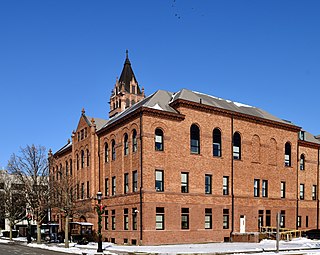
The Downtown Urbana Historic District is a commercial historic district encompassing seven city blocks in downtown Urbana, Illinois. The buildings in the district reflects downtown Urbana's development as the county seat of Champaign County and a regional commercial center. While Urbana was founded in the 1830s and began its development in the ensuing decades, the oldest buildings in the district are from the 1870s. The city expanded considerably in the late nineteenth and early to mid twentieth centuries, and most of the district's buildings were constructed during this period. Local architect Joseph Royer designed many of the district's most prominent buildings, including the 1901 Romanesque Revival Champaign County Courthouse.

The Champaign Downtown Commercial District is a commercial historic district encompassing 19.4 acres (7.9 ha) in downtown Champaign, Illinois. The district includes some of the oldest parts of the city's downtown, and its buildings represent the city's development in the late nineteenth and early twentieth centuries. Champaign was founded in the 1850s when the Illinois Central Railroad added a station in a rural area west of neighboring Urbana and the town formed around it; the oldest buildings in the district date from the following decade. Several buildings connected to the Illinois Central are included in the district. The opening of the University of Illinois at Urbana–Champaign in 1867 furthered Champaign's growth, and development in the downtown commercial district continued steadily through 1940. The district's commercial buildings exhibit a variety of building types and architectural styles, including Italianate, Art Deco, and various revival styles. Champaign's City Building and other local government buildings are also part of the district.
